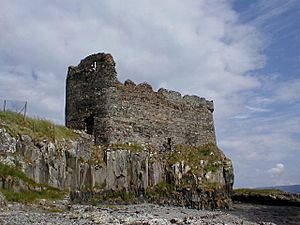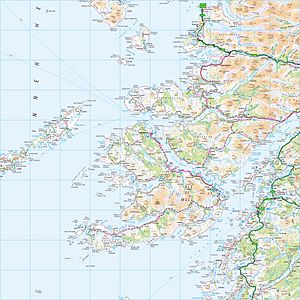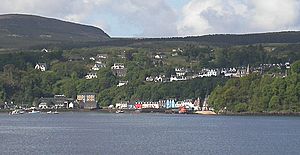San Juan de Sicilia facts for kids
Quick facts for kids History |
|
|---|---|
| Name | Brod Martolosi |
| Out of service | seized by the viceroy of Sicily for service in the Spanish fleet, December 1586 |
| Name | San Juan de Sicilia |
| Acquired | for the Spanish fleet, December 1586 |
| Fate | exploded and sank off the Isle of Mull, Scotland, 5 November 1588 |
| General characteristics | |
| Class and type | Spanish galleon |
| Tons burthen | 800 |
| Complement | 62 crewmen; 287 soldiers |
| Armament | 26 guns |
The San Juan de Sicilia was a large Spanish ship that was part of the famous Spanish Armada in 1588. This huge fleet of 130 ships tried to invade England. The ship was originally called the Brod Martolosi. It was later taken by the Spanish navy.
The San Juan de Sicilia was one of 10 ships in the Levant squadron. This was one of eight groups that made up the entire Armada. Sadly, the ship was wrecked near the Isle of Mull in Scotland. For many years, people forgot the ship's real name. Rumors spread that it was a treasure ship filled with gold. But later, its true identity was discovered.
Contents
The Spanish Armada's Journey
The San Juan de Sicilia was one of many ships forced to join the Spanish Armada. It was first known as the Brod Martolosi. This ship came from Ragusa, which is now Dubrovnik. Its captain was Luka Ivanov Kinkovic. In December 1586, the viceroy of Sicily took control of this ship and others.
The ship was renamed the Santa Maria de Gracia y san Juan Bautista. However, many ships were named after St John the Baptist. So, it became known as the San Juan de Sicilia. This helped people tell it apart from the other ships.
Ship's Size and Crew
The San Juan de Sicilia was a very large ship. Only about 20 of the 130 ships in the Armada were bigger. It had a crew of 62 sailors, mostly from Slavic countries. Its captain was Luka Ivanov Kinkovic.
The ship also carried 287 soldiers. These included:
The San Juan de Sicilia was badly damaged during battles with English ships.
Scotland and the Ship's End

On September 23, 1588, the San Juan de Sicilia was seen near Islay. A few days later, it landed in Tobermory Bay on the Isle of Mull. The ship itself was not damaged. But the crew needed fresh water. The ship's senior officer, Diego Tellez Enríquez, made a deal. He asked the local chief, Lachlan MacLean of Duart, for supplies. In return, Spanish soldiers would help MacLean fight his enemies.
For over a month, the San Juan de Sicilia stayed in the bay. Spanish troops helped MacLean by attacking nearby islands. They raided Rùm and Eigg, which belonged to MacDonald of Clanranald. They also attacked Canna and Muck, owned by MacIan of Ardnamurchan. The soldiers even helped lay siege to Mingary Castle for three days.
The Explosion
One person who supplied the ship was John Smollet. He was from Dumbarton. Many believe he was secretly working for Sir Francis Walsingham, an English spy. On November 5, 1588, the ship suddenly exploded. Almost everyone on board died, including five hostages MacLean had given to the Spanish.
About fifty survivors were kept by MacLean of Duart. He used them in his own fights for another year. After that, he sent them back to Spain.
Myths of Spanish Gold
Years after the San Juan de Sicilia sank, people forgot its true identity. Rumors of Spanish gold linked to the wreck began to spread. In 1677, people called it "the Armada treasure-ship." They said it was named the Florida and was the main ship of the Spanish fleet. They even claimed it held "30,000,000 of money."
However, these were just stories. The real main ship of the fleet made it back safely. Also, no ship named Florida was part of the Spanish Armada. The "treasure-ship" was also sometimes called the Florencia. But the real Florencia also survived the journey. It wasn't until the early 1900s that experts finally figured out the ship's true identity.
It was also confusing because several ships were named San Juan. There were at least nine of them! Also, at least two men named Diego Enríquez were in the fleet. This made it hard to know which ship was which.
Searching for the Wreck
People have tried to find things from the wreck since the 1600s. The first attempts might have been by Swedish divers. They had found items from the Swedish ship Wasa, which sank in 1628.
Over the years, many people tried to find treasure. The Earl of Argyll started some of the earliest dives. Later, the rights to search for the wreck changed hands many times. In 1729, the 2nd Duke of Argyll hired divers. They used explosives and winches to break up the wreck. But they found no treasure. People continued to search for the wreck all the way into the late 1900s. One of the divers was Margaret Naylor, the first woman surface supplied diver.
Items Found
Many objects have been found from the wreck over the years. These include:
- Guns
- Anchors
- Pewter plates
- Medals
Around 1740, a bronze cannon was recovered. This type of cannon was called a medio cañón. It fired heavy cannonballs. This particular gun has the symbol of Francis I of France, who was the King of France. It might have been captured by the Spanish in a battle in 1557 or 1525. Today, this cannon is at Inveraray Castle.
See also



